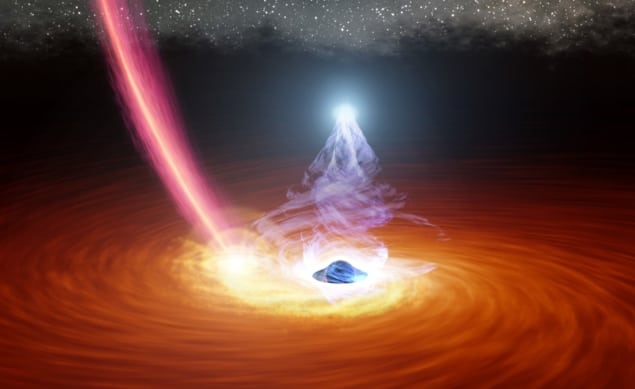
Over the course of just one year, the bright X-ray corona surrounding a supermassive black hole dipped dramatically in brightness, before steadily recovering its initial luminosity. The event was observed by an international team of astronomers, led by Claudio Ricci at Diego Portales University in Chile, who suggest that the dimming could have been caused by a wayward star being torn apart by tidal forces. The team’s findings could lead to a better understanding of how X-ray coronas form in the first place.
Most normal galaxies are centred on a super massive black hole that creates an active galactic nucleus (AGN) – an extremely bright source of radiation created as matter accelerates into the black hole. AGN’s are known to host bright coronas of X-rays within their inner accretion disks. While the processes by which these structures form are not fully understood, they are thought to involve tangled magnetic fields situated close to the black hole. As these fields interact with hot electrons in the accretion disk, energy is transferred to surrounding photons to create high-energy X-rays.
In March 2018, Ohio State University’s All-Sky Automated Survey for Supernovae programme detected that an AGN 100 million light-years away called 1ES 1927+654 had surged to around 40 times its usual brightness at optical and ultraviolet wavelengths. This prompted Ricci’s team to closely monitor the object’s X-ray corona for any subsequent changes. To do this, they took frequent, measurements of the AGN using NASA’s NICER telescope, located aboard the International Space Station.
Dramatic drop
Following the initial brightening event, NICER’s measurements showed that the AGN’s corona plummeted in brightness by a factor of 10,000 in less than two months. In one instance, its brightness dropped by a factor of 100 in just 8 h. Then, after reaching its dimmest point at about 200 days after the first optical observation in March, the corona steadily increased in brightness; almost reaching pre-outburst levels around 300 days after the beginning of the event – signalling that the structure had re-formed.
Until now, astronomers had thought that such dramatic variations could only play out over thousands, or even millions of years – leading Ricci’s team to propose an updated theory. Their calculations suggest that the event could have been triggered by a star that wandered too close to the black hole and was ripped apart by gravity.

Is black hole at the centre of NGC 4395 a primordial relic?
Afterwards, debris from the star would have knocked away material in the AGN’s inner accretion disk, causing much of it to suddenly fall into the black hole. This would destroy the tangled magnetic field lines, abruptly switching-off the power supply that drives the X-ray corona. Afterwards, material in the disk would be replenished, allowing the X-ray corona to return.
If this theory is correct, it would have important implications for astronomers’ understanding of how AGN coronas form; suggesting that only magnetic fields within their tidal disruption radii could be responsible for creating the structures. Ricci’s team will now continue to monitor 1ES 1927+654 for any further variations in brightness, which will enable them to constrain their predictions further.
The research is described in The Astrophysical Journal Letters.



